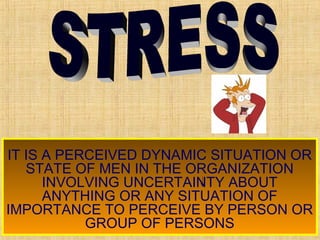Organisational.stress
- 1. IT IS A PERCEIVED DYNAMIC SITUATION OR STATE OF MEN IN THE ORGANIZATION INVOLVING UNCERTAINTY ABOUT ANYTHING OR ANY SITUATION OF IMPORTANCE TO PERCEIVE BY PERSON OR GROUP OF PERSONS
- 2. GENERALIZED EFFECTS OFGENERALIZED EFFECTS OF STRESSSTRESS Organizational stress may generate a positive effect (challenging attitude) or may precipitate a negative effect (frustrating and discouraging mental state). It is generated by person-environment transaction (frustrating and discouraging mental state). It is generated by person-environment transaction (reciprocal interaction) in relation to personal needs and values and sociopsychological conditions. (Schuler, 1984). The more events (across situations and over time) in the organization are perceived as stressful, the more stress is felt. Negative events can be associated with the automatic nervous system and central nervous system. According to Schuler (1984), prolonged exposure to uncertainty in organizational in organizational environment and situation make the involved person(s) a victim of stress.
- 3. SCHULER INTEGRATIVE TRANSACTIONALPROCESS MODELSCHULER INTEGRATIVE TRANSACTIONALPROCESS MODEL Environmental Stressors Individual Perception Stress Responses of the perceiver Individual Perception Long Short Psychophysical disturbance Exhaustion Breakdown Reflect on individuals Reflect on individuals Ability/ Efficiency/ Self-Reliance/ Goodwill/ Lifestyle/ Accident Fitness/ Lifestyle/ Social support/ Self-Esteem/ Integrity Depends on individual characteristics in relation to Organizational life Individual qualities Roll/ Worthiness/ Human relations/ Career Needs/ Values/ Type/ Abilities/ Focus on control behavior/ Life changes
- 4. FACTORS ASSOCIATED WITHFACTORS ASSOCIATED WITH MANAGERIAL STRESSMANAGERIAL STRESS (Reported by Cooper, Howard, McLean & Warshaw)(Reported by Cooper, Howard, McLean & Warshaw) (i) Consequences of decision making (ii) Responsibility for people (iii) Heavy demand for cooperation- with superiors and subordinates (iv)Time pressure (v) Fear for failure (vi)Fear for poor performance (vii)Mid-career crisis or stagnancy (viii)Lack of power/ prestige (ix)Managing workforce with rapidly changing values
- 5. SYMPTOMS OF MANAGERIALSYMPTOMS OF MANAGERIAL STRESSSTRESS (Reported by Martindale, 1977)(Reported by Martindale, 1977) (i) Ulcers (ii) High blood pressure (iii) Arthritis (iv)Colitis (v) Headache (vi)Allergy (vii)Stomach upset (viii)Alcoholism (ix)Depression (x) Acute anxiety
- 6. COPING- DEALING WITH STRESSCOPING- DEALING WITH STRESS Coping is defined as “efforts to manage (control, tolerate, reduce and minimize) conflicting environmental and internal demands which tax upon or exceeds a person’s resources (limits)” (Lazarus, 1978). Coping Behavior “Protects people from psychologically harmed by problematic social experience” (Pearlin & Schooler, 1978). Coping Strategy Aims at moderating stressor in the environment as per as practicable, to protect the victim and control victimization from the adverse effect of any stressor and its negative outcome (yet to take advantage of its positive outcome).
- 7. POSSIBLE SOURCES OFPOSSIBLE SOURCES OF ORGANISATIONAL STRESSORGANISATIONAL STRESS (i) Lack of cooperative group participation (ii) Poor interpersonal relationship (iii) Poor communication (iv)Restriction of behavior (v) Highly limited opportunity for advancement (vi)Inequity in pay and performance appraisal
- 8. POSSIBLE STRATIGIES TO REDUCEPOSSIBLE STRATIGIES TO REDUCE OR ELIMINATE ORGANISATIONALOR ELIMINATE ORGANISATIONAL STRESSSTRESS(i) Clarification of transfer and promotion policies (ii) Decentralization and increased participation (iii) Change in the selection and placement policies (iv)Change in the procedure and network communication (v) Change in the reward system (vi)Utilization of training and development progrmme (vii)Statement of performance evaluation system (viii)Development and utilization of permanent and temporary work group (ix)Change in shift pattern and job rotation policies








